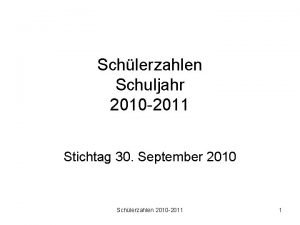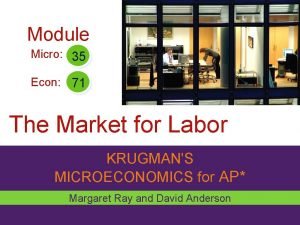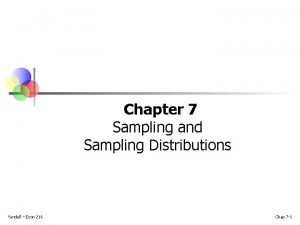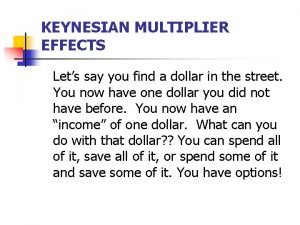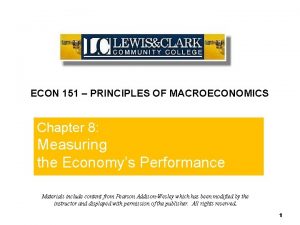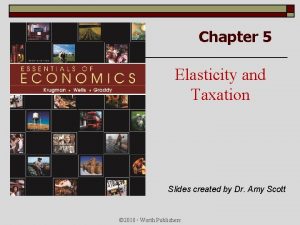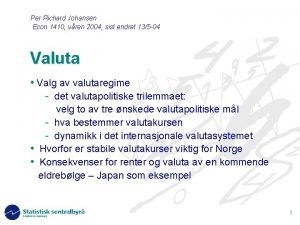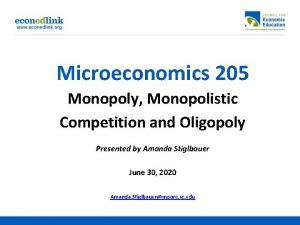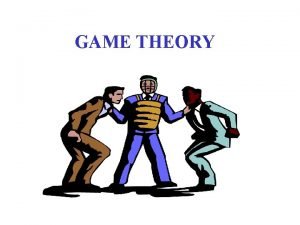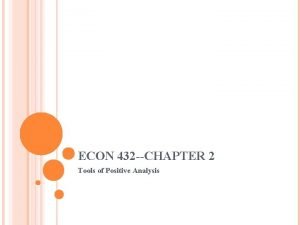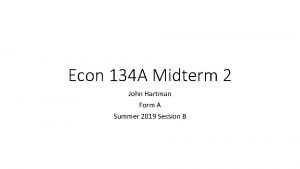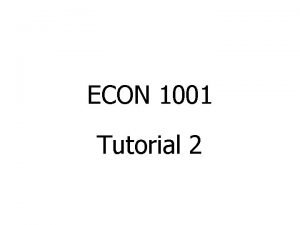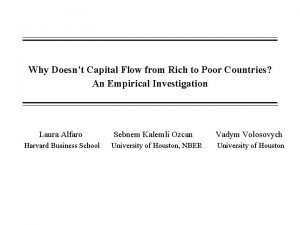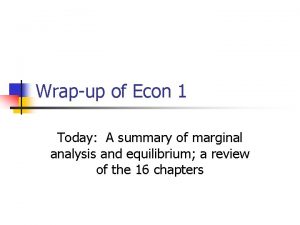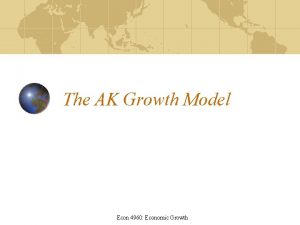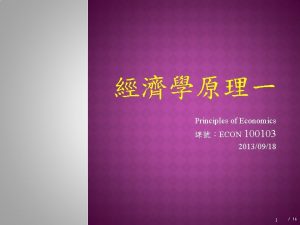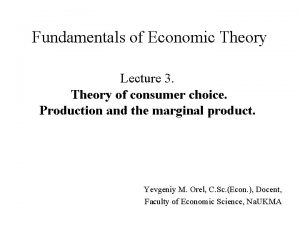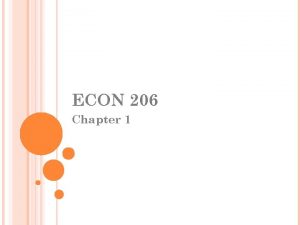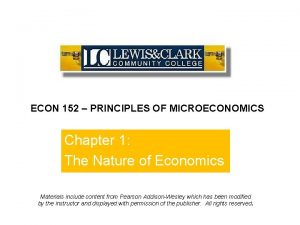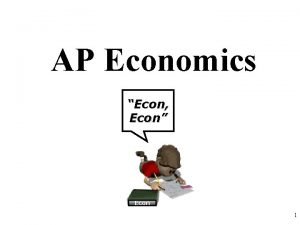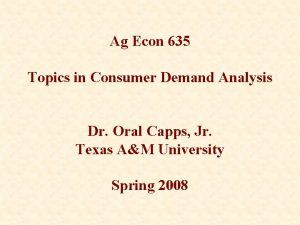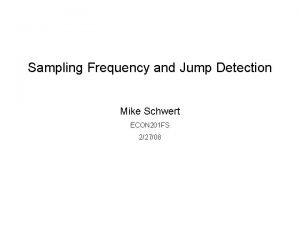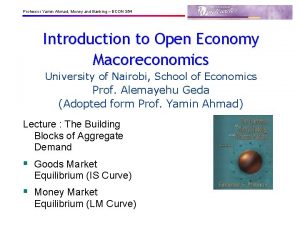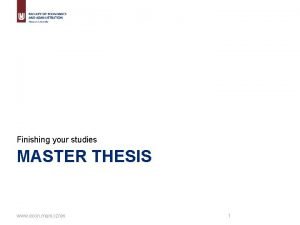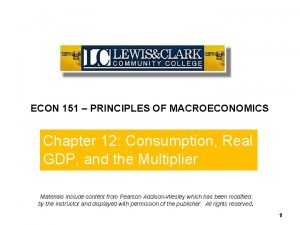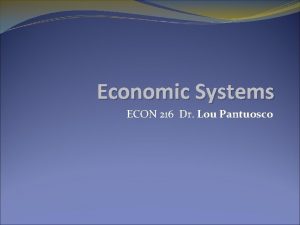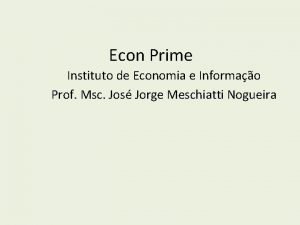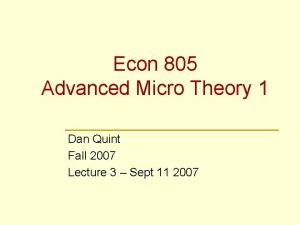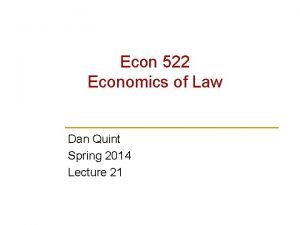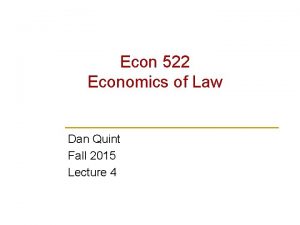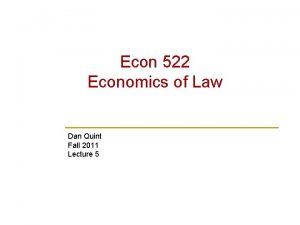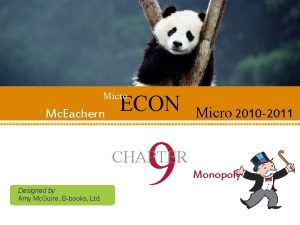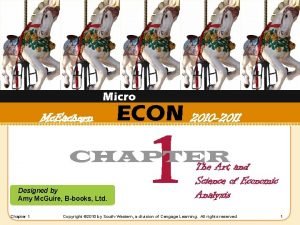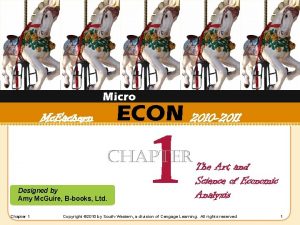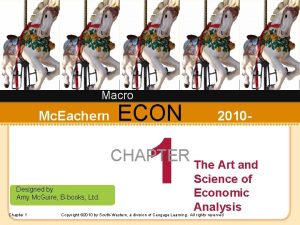Micro Mc Eachern ECON 2010 2011 11 CHAPTER











































- Slides: 43

Micro Mc. Eachern ECON 2010 -2011 11 CHAPTER Designed by Amy Mc. Guire, B-books, Ltd. Chapter 11 Resource Markets Copyright © 2010 by South-Western, a division of Cengage Learning. All rights reserved 1

Demand Supply of Resources u Resource demand u Firms demand resources u As long as MR>MC u To maximize profit u Resource supply u People supply resources u To the highest-paying alternative u To maximize utility LO 1 Chapter 11 Copyright © 2010 by South-Western, a division of Cengage Learning. All rights reserved 2

Resource Market for Carpenters Dollars per hour of labor Exhibit 1 LO 2 S W D 0 E Hours of labor period The intersection of the upward-sloping supply curve of carpenters with the downwardsloping demand curve determines the equilibrium wage, W, and the level of employment, E. Chapter 11 Copyright © 2010 by South-Western, a division of Cengage Learning. All rights reserved 3

The Market Demand for Resources u Resource demand u Derived demand u Arises from the demand for the final product u Market demand u Sum of demands for a resource u In all its uses u Downward sloping LO 2 Chapter 11 Copyright © 2010 by South-Western, a division of Cengage Learning. All rights reserved 4

What is Derived Demand? The demand for labor and other factors of production depends on the consumer demand for final goods and services the factors produce. Chapter 11 Copyright © 2010 by South-Western, a division of Cengage Learning. All rights reserved 5

Demand for factors z. The demand for a factor of production is a derived demand z. Firms hire the quantities of factors of production that maximize their profits z. They hire an additional unit of a factor of production if the additional revenue brought in exceeds the additional cost Chapter 11 Copyright © 2010 by South-Western, a division of Cengage Learning. All rights reserved 6

Resource Demand Curve u Inverse Relationship u As price falls, producers u More willing to buy u Relatively cheaper u Substitution in production u Greater ability to buy u Hire more at the same total cost LO 2 Chapter 11 Copyright © 2010 by South-Western, a division of Cengage Learning. All rights reserved 7

Demand for factors The revenue generated in by one additional unit of a factor of production is the marginal revenue product of that factor The cost of hiring an additional unit of a factor of production is the Marginal Resource Cost of that factor. In Competitive Markets the MRP = MP X Product Price. In Competitive Labor Markets the MRC = market price of the resource Chapter 11 Copyright © 2010 by South-Western, a division of Cengage Learning. All rights reserved 8

Marginal Productivity Theory of Resource Demand Marginal Product -- MP = TP / QL Marginal Revenue Product MRP = TR / QL • Productivity • Product Price Marginal Resource Cost MRC = TC / QL Rule for Employing Resources: Chapter 11 MRP = MRC Copyright © 2010 by South-Western, a division of Cengage Learning. All rights reserved 9

Resource Demand Rule for Employing Resources: MRP = MRC Marginal Revenue Product (MRP) Marginal Revenue Product = Change in Total Revenue Unit Change in Resource Quantity Marginal Resource Cost (MRC) Marginal Resource Cost Chapter 11 = Change in Total (Resource) Cost Unit Change in Resource Quantity Copyright © 2010 by South-Western, a division of Cengage Learning. All rights reserved 10

Market Demand for a Resource Determinants of Resource Demand – Changes in Productivity • Quantities of Other Resources • Technological Advance • Quality of Variable Resources Chapter 11 Copyright © 2010 by South-Western, a division of Cengage Learning. All rights reserved 11

The Market Supply of Resources u Market supply u Sum of all individual supply curves u Upward sloping u As price rises, resource suppliers u More willing to sell u Higher earnings u More goods and services purchased u More able to increase quantity supplied LO 2 Chapter 11 Copyright © 2010 by South-Western, a division of Cengage Learning. All rights reserved 12

Resource Price Differences u Resources u Flow to their highest-valued use u If freely mobile u Adjust across different uses until they earn the same wage u Temporary differences u Market adjustments u Reallocation of resources LO 2 Chapter 11 Copyright © 2010 by South-Western, a division of Cengage Learning. All rights reserved 13

LO 2 Exhibit 2 Market for Carpenters in Alternative Uses (b) Furniture making Sh S’h $25 24 Dollars per hour (a) Home building S’f Sf $24 20 Df Dh 0 0 58 60 Hours of labor per day (thousands) 10 12 Hours of labor per day (thousands) The wage differential prompts carpenters to shift from furniture making to home building until the wage is identical in the two markets Chapter 11 Copyright © 2010 by South-Western, a division of Cengage Learning. All rights reserved 14

Resource Price Differences u Permanent differences u Lack of resource mobility u Inherent quality of the resource u Time and money involved in developing necessary skills u Nonmonetary aspects of the job LO 2 Chapter 11 Copyright © 2010 by South-Western, a division of Cengage Learning. All rights reserved 15

Optimal Combination of Resources The Least-Cost Rule Least-Cost Combination of Resources Marginal Product Of Labor (MPL) Price of Labor (PL) Chapter 11 = Marginal Product Of Capital (MPC) Price of Capital (PC) Copyright © 2010 by South-Western, a division of Cengage Learning. All rights reserved 16

Optimal Combination of Resources The Profit-Maximizing Rule: MRP (Resource) = P (Resource) Profit Maximizing Combination of Resources PL = MRPL and MRPL PL Chapter 11 = PC = MRPC PC =1 Copyright © 2010 by South-Western, a division of Cengage Learning. All rights reserved 17

Optimum Combination of Resources Profit-Maximizing Combination MRPL MRPC MFCL MFCC 1 The firm will employ resources to the point where: MRPL = PL & MRPC = PC Chapter 11 Copyright © 2010 by South-Western, a division of Cengage Learning. All rights reserved 18

Optimum Combination of Resources Least - Cost Rule MPP of Labor Price of Labor MPP of Capital Price of Capital What if: MPPL / PL > MPPC / PC The firm could get more output / dollar using more Labor, and lower its cost. Chapter 11 Copyright © 2010 by South-Western, a division of Cengage Learning. All rights reserved 19

LO 4 The Firm’s Demand for a Resource § Quantity of resource L § Total product TP, Q § Quantity of output § Marginal product MP=∆TP/∆L § Diminishing marginal returns § Marginal revenue product MRP=∆TR/∆L § How much total revenue changes as more labor is employed § Depends on ∆Q and P Chapter 11 Copyright © 2010 by South-Western, a division of Cengage Learning. All rights reserved 20

LO 4 Marginal Revenue Product § MRP curve = Firm’s demand curve for the resource § Perfectly competitive product market: MRP = MP×P § MRP curve slopes downward § Diminishing marginal returns to resource § Some market power in product market § MRP curve slopes downward § Diminishing marginal returns to resource § Additional output can be sold only if price falls Chapter 11 Copyright © 2010 by South-Western, a division of Cengage Learning. All rights reserved 21

Perfect Competition MRP is a Demand Schedule Units of resource 0 1 Marginal Total product Product price MP 0 $2 ] 7 7 2 ] ] ] Resource price (wage rate) P Chapter 11 14 12 10 8 6 4 20 1 2 3 4 5 Marginal Total revenue product MRP $ 0 ] $ 14 14 ] ] ] 6 7 8 Copyright © 2010 by South-Western, a division of Cengage Learning. All rights reserved Quantity of resource demanded 22

Perfect Competition MRP is a Demand Schedule Units of resource 0 1 2 Marginal Total product Product price MP 0 $2 ] 7 7 2 6 13 ] 2 ] ] Resource price (wage rate) P Chapter 11 14 12 10 8 6 4 20 1 2 3 4 5 Marginal Total revenue product MRP $ 0 ] $ 14 14 12 26 ] ] ] 6 7 8 Copyright © 2010 by South-Western, a division of Cengage Learning. All rights reserved Quantity of resource demanded 23

Perfect Competition MRP is a Demand Schedule Units of resource 0 1 2 3 4 5 6 7 Marginal Total product Product price MP 0 $2 ] 7 7 2 6 13 ] 2 5 18 2 ] 4 22 2 3 25 ] 2 2 27 ] 2 1 28 2 ] Resource price (wage rate) P Chapter 11 14 12 10 8 6 4 20 Marginal Total revenue product MRP $ 0 ] $ 14 14 12 26 ] 10 36 ] 8 44 6 50 ] 4 54 ] 2 56 ] The purely competitive firm’s demand for a resource MRP 1 2 3 4 5 6 7 8 Copyright © 2010 by South-Western, a division of Cengage Learning. All rights reserved Quantity of resource demanded 24

Demand for factors in Imperfect Competition The revenue generated in by one additional unit of a factor of production is the marginal revenue product of that factor. The cost of hiring an additional unit of a factor of production is the Marginal Resource Cost of that factor. In Imperfectly Competitive Markets the MRP = MR X MP or MRP = TR / QL Chapter 11 Copyright © 2010 by South-Western, a division of Cengage Learning. All rights reserved 25

Imperfect Competition MRP is a Demand Schedule Units of resource Resource price (wage rate) 0 1 2 3 4 5 6 7 Marginal Total product Product price MP 0 ] $2. 80 7 7 2. 60 6 13 ] 2. 40 5 18 ] 2. 20 4 22 2. 00 3 25 ] 1. 85 2 27 ] 1. 75 1 28 1. 65 ] Chapter 11 14 12 10 8 6 4 20 Marginal Total revenue product MRP $ 0 ] $ 18. 20 13. 00 31. 20 ] 8. 40 39. 60 ] 4. 40 44. 00 2. 25 46. 25 ] 1. 00 47. 25 ] -1. 05 46. 20 ] MRP 1 2 3 4 5 6 7 8 Copyright © 2010 by South-Western, a division of Cengage Learning. All rights reserved Quantity of resource demanded 26

Imperfect Competition MRP is a Demand Schedule Units of resource Resource price (wage rate) 0 1 2 3 4 5 6 7 Chapter 11 Marginal Total revenue product MRP $ 0 ] $ 18. 20 13. 00 31. 20 ] 8. 40 39. 60 ] 4. 40 44. 00 2. 25 46. 25 ] 1. 00 47. 25 ] -1. 05 46. 20 ] Marginal Total product Product price MP 0 ] $2. 80 7 7 2. 60 6 13 ] 2. 40 5 18 ] 2. 20 4 22 2. 00 3 25 ] 1. 85 2 27 ] 1. 75 1 28 1. 65 ] 14 12 10 8 6 4 20 The imperfectly competitive seller’s demand for a resource MRP 1 2 3 4 5 6 Q 7 8 Copyright © 2010 by South-Western, a division of Cengage Learning. All rights reserved Quantity of resource demanded 27

Resource Price Comparison of Demand for Labor for Perfect Comp. And Imperfect Comp. The firms labor demand curve will fall more rapidly in imperfect competition because the price must be lowered to sell additional units. 10 8 6 4 2 MRPIPC 0 Chapter 11 2 4 6 MRPPC 8 10 Quantity of Resource Copyright © 2010 by South-Western, a division of Cengage Learning. All rights reserved 28

Marginal Revenue Product When a Firm Sells in a Perfectly Competitive Market Exhibit 4 LO 4 Chapter 11 Copyright © 2010 by South-Western, a division of Cengage Learning. All rights reserved 29

Marginal Revenue Product When a Firm Sells in a market with Market Power Exhibit 5 LO 4 Chapter 11 Copyright © 2010 by South-Western, a division of Cengage Learning. All rights reserved 30

LO 4 Marginal Resource Cost § Marginal resource cost MRC=∆TC/∆L § Change in total cost when hiring one more unit of labor § MRC curve § Horizontal curve at the equilibrium market wage § Maximize profit § Hire resources until MRC=MRP Chapter 11 Copyright © 2010 by South-Western, a division of Cengage Learning. All rights reserved 31

Exhibit 6 LO 4 Market Equilibrium for a Resource and the Firm’s Employment Decision (b) Firm Resource supply $200 100 Resource demand 0 E Workers per day Dollars per worker per day (a) Market $200 100 0 Marginal revenue product = Resource demand Marginal resource cost = Resource supply 6 10 Workers per day In panel (a), market demand supply determine the resource’s market wage and quantity. In panel (b), an individual firm can employ as much as it wants at the market wage so that wage becomes the firm’s MRC. The firm maximizes profit (or minimizes its loss) by hiring a resource up to the point where MRP = MRC. Chapter 11 Copyright © 2010 by South-Western, a division of Cengage Learning. All rights reserved 32

How Much Labor to Employ? in a Competitive Firm and Market Wage Rate S ($6) W c MRC Wc D d = MRP Q Quantity of Labor Individual Firm Chapter 11 D = ( mrp’s) (1000) Quantity of Labor Market Copyright © 2010 by South-Western, a division of Cengage Learning. All rights reserved 33

Equating MRP and MFC Price of Factor The competitive firm will hire inputs as long as: MRP > MFC The firm will maximize profit where: MRP = MFC Chapter 11 MRP = MFC P 1 MFC MRP 0 Q 1 Quantity of the Factor Copyright © 2010 by South-Western, a division of Cengage Learning. All rights reserved 34

LO 4 Changes in Resource Demand § Changes in MRP (demand) § Marginal product of the resource § Amount of other resources employed § Substitutes § Complements § Technology § Product’s price § Change in demand for the product § Demand for resource = derived demand Chapter 11 Copyright © 2010 by South-Western, a division of Cengage Learning. All rights reserved 35

Change in the Price of Other Resources Substitution Effect PL - increases, substitute Capital and use less labor. Output Effect PC - decreases, it cost less to produce. Produce more and hire more labor. Complementary Resources Labor and capital must be used in a constant proportion. Lower cost capital- use more capital and more labor. Chapter 11 Copyright © 2010 by South-Western, a division of Cengage Learning. All rights reserved 36

Resource Price Change in the Quantity Demanded of a Resource A Decrease in the Price of a Resource will increase the Quantity Demanded. 10 8 6 4 2 0 Chapter 11 Demand for Labor 2 4 6 8 10 Quantity of Resource Copyright © 2010 by South-Western, a division of Cengage Learning. All rights reserved 37

Resource. Price Change in Resource Demand 6 An Increase in Product Price will increase resource Demand. 5 4 3 2 1 DL 1 0 Chapter 11 2 4 6 DL 2 8 10 Quantity of Resource Copyright © 2010 by South-Western, a division of Cengage Learning. All rights reserved 38

Resource. Price Change in Resource Demand 6 A reduction in the price of Substitute inputs will decrease resource Demand. 5 4 3 2 1 DL 2 0 Chapter 11 2 4 6 DL 1 8 10 Quantity of Resource Copyright © 2010 by South-Western, a division of Cengage Learning. All rights reserved 39

Change in Resource Demand The Demand for Labor will Increase if: • Price of the product increases (demand for the product increases). • The Marginal Product of Labor increases. • The price of a substitute input increases (if substitution effect > output effect). • The price of a complementary input decreases Chapter 11 Copyright © 2010 by South-Western, a division of Cengage Learning. All rights reserved 40

Case Study LO 4 The Mc. Minimum Wage Chapter 11 u May 2007, minimum hourly wage $7. 25 u Only 4% workers earned less u Advocates u Increase the income of the poorest workers u Critics u Encourage employers to u Cut nonwage compensation u Scale back employment Copyright © 2010 by South-Western, a division of Cengage Learning. All rights reserved 41

Case Study LO 4 The Mc. Minimum Wage Chapter 11 u Higher minimum wage u Employers u Substitute part-time for full-time jobs u Substitute more qualified for less qualified workers u Adjust nonwage components u Higher opportunity cost of staying in school Copyright © 2010 by South-Western, a division of Cengage Learning. All rights reserved 42

Key Terms • • Chapter 11 derived demand marginal product marginal revenue product marginal resource cost MRP = MRC rule substitution effect least-cost combination of resources profit-maximizing combination of resources Copyright © 2010 by South-Western, a division of Cengage Learning. All rights reserved 43
 Schuljahr 2010/2011
Schuljahr 2010/2011 2010 micro frq
2010 micro frq Econ chapter 7
Econ chapter 7 How to find tax multiplier
How to find tax multiplier Fiscal policy ib economics
Fiscal policy ib economics Flipitecon
Flipitecon Econ 151
Econ 151 Mid point formula econ
Mid point formula econ Mpc and gdp
Mpc and gdp Marginal analysis in economics
Marginal analysis in economics Econ austria
Econ austria Econ 1410
Econ 1410 Econ 424
Econ 424 Mr darp econ
Mr darp econ What is game theory
What is game theory Positive analysis:
Positive analysis: Econ 134
Econ 134 Econ
Econ Esf muni harmonogram
Esf muni harmonogram Gertler econ
Gertler econ Velocity formula econ
Velocity formula econ Econ
Econ Econ
Econ Econ
Econ Nthu econ
Nthu econ Sports economics definition
Sports economics definition Econ
Econ Econ 206
Econ 206 Econ 152
Econ 152 Econ
Econ Econ
Econ Econ muni
Econ muni Econ
Econ Econ 25
Econ 25 Monopoly economics
Monopoly economics Econ ra twitter
Econ ra twitter Is muni thesis
Is muni thesis Gdp formula
Gdp formula Econ
Econ Prime econ
Prime econ Dan quint
Dan quint Econ
Econ Econ
Econ Econ
Econ
